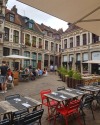Suizenji Joju-en Park
Suizenji Joju-en is a beautiful park in Kumamoto. When we visited at the end of October last year, it was still lush and green; the autumn colours still to descend.
Daimyo (feudal lord) Hosokawa Tadatoshi originally built a temple, Suizenji, on the site in 1632 but just four years later he replaced it with a tea house, designating the new surrounding gardens a tea retreat; he believed the natural spring-fed water (from nearby Mount Aso) made excellent tea. Tadatoshi named the garden Joju-en for a character in a poem by 4th century Chinese poet Tao Yuanming. Both titles form part of the full name of the park today.
The garden took subsequent generations of the family a further 80 years to develop and represents, in miniature form, the 53 post stations of Tokaido, the road that connected Tokyo with Kyoto during the Edo Period. The largest of the many rounded tsukiyama (artificial hills) represents Mount Fuji.
It is typical of the Momoyama period of garden design – a central lake is bordered by artfully arranged boulders and pebbles and there are stepping stones within. Paths wind through the gardens, showcasing landscapes designed to be admired from a distance; they are connected by low stone bridges over the lake.
The Izumi (Inari) Shinto Shrine was built in 1878 as a memorial to the Hosokawa rulers and the garden became a public park in 1879. The impressively thatched tea room, Kokin-Denju-no-Ma, was originally in Kyoto’s Imperial Palace but was moved to the park in 1912.
With the sun shining, we took our time to walk around, pausing to admire the view along the route and resting on benches beneath the trees. I was particularly mesmerised by the park gardeners, mowing the tsukiyama in ever-ascending circles, around and around and around…
Inside the park, there were also a few souvenir and produce shops, including one selling “Kumamoto Banpeiyu” fruit. As far as I can tell, it’s a Japanese cross between a yellow-fleshed pomelo and a red-fleshed grapefruit.
Sweet Potato Dumplings
Sweet potatoes – both yellow and purple varieties – are very popular in Japan. In Kumamoto, the purple kind feature in a variety of local sweets.
One type, is imokoi; imo means potato and koi can mean either love or a dark colour, so it’s either “dark colour potato” or “potato love”, I’m not sure which! And I love that the local name is ikinari dango which means “all of a sudden sweet round dumpling”, so-called because it’s said to be a treat one can make very quickly for unexpected visitors. Inside a glutinous rice wrapper is a layer of sweet potato and another of sweet azuki (red bean) paste.
Another plainer dumpling contains a sweet potato filling within a glutinous rice wrapper.
This stall outside the entrance to Suizenji Joju-en Park was selling the simpler dumplings for just ¥ 85 (56 pence) each. There were also whole sweet potatoes available, but no ikinari dango on sale, though they were shown on a laminated picture list of products. When I asked if I could take some photographs, the owner nodded, pointing out the large poster portraits hanging behind her and her colleagues; I gather her shop had been featured in a documentary or magazine.
Entrance to Suizenji Joju-en Park is ¥ 400.
































Please leave a comment - I love hearing from you!7 Comments to "Suizenji Joju-en Park and Sweet Potato Dumplings in Kumamoto"
Yum! I had something similar when I was there.
When I went to Okinawa, I was amazed by how much people there seem to love purple sweet potato! There were so many shops selling different kinds of sweet potato cakes /desserts, many with a cartoon character sweet potato logo outside! The most popular dessert there seemed to be this little pastry case shaped like a boat filled with the purple sweet potato cream. Everyone was buying boxes as souvenirs.
That cream one sounds amazing! I could spend a year eating my way around Japan and still want more!
The park looks beautiful, so serene, so peaceful. Each direction you look in, it is like a picture, just beautiful.
Those sweet potato balls sound nice. I love sweet potatoes. We had these http://goo.gl/7Pc751 in China a few years back, delicious. Your post reminded me of them, I should make them next time I but sweet potatoes.
beautiful and serene. Loved those sweet potato dumplings too. Had them often with some moogicha
Lovely!
Deve ter sido lindo esse passeio pelo parque. Muito obrigado por compartilhar sua experiência e história a respeito desse maravilhoso parque. Acho que quando a gente se encanta com o lugar , queremos saber mais sobre ele. Parabéns pelas lindas fotos , da origem do parque e as dicas de guloseimas ao redor. おめでとう。
It’s my favorite food when I was in there for learning in Kumamoto University Hospital. I like sweet potato dumplings of that shop. I miss that and wanna know how to make it because i have no chance to be there more.
I’m a Myanmar.